History of Kobe Customs
Foundation (The Keio Period)
The predecessor of Kobe Customs is Hyogo Unjosho, a customhouse established by the Tokugawa shogunate on January 1, 1868 (December 7, the 3rd year of the Keio period), at the time of the opening of Hyogo seaport for international trade.
On November 28, 1872 (the 5th year of the Meiji period), all Japanese Unjosho were decided to be renamed to Customs, and the Hyogo Unjosho was officially renamed to Kobe Customs on January 4, 1873.
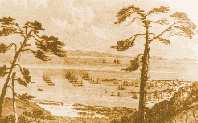
The Kobe port seen from Mt. Suwa at the time of opening
[Provided from Kobe City museum]
The first building of Kobe Customs headquarters office (1873-1922)
The construction of the first buildings of the headquarters office started in February 1872 and was completed in December 1873. It was a two-storied fine stone building, with the imperial chrysanthemum crest decorated on the front entrance facing the sea.

Growth (The Meiji & Taisho Periods)
The foreign trade expanded remarkably under the modernization policy started with the Meiji Restoration. Kobe Customs kept growing, along with the development of the hinterland industries of Kobe port.In the late Meiji period, the modern Customs system was estabilshed with the enactment of Customs laws and regulations.
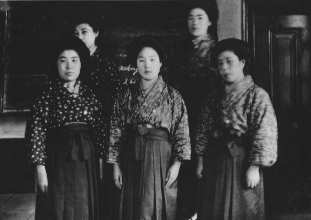
The first female inspectors in Japanese Customs in 1922
(the 11th year of the Taisho Period).
The second building of Kobe Customs headquarters office (1927-1996)
The construction of the second headquarters office building started in April 1923 (the 12th year of the Taisho period) and was completed in March 1927 (the 2nd year of the Showa Period).
It was the most modern building of the time as the keeper of the country, proud of its magnificent appearance with granites and tiles decorated over the building.

Development (the Showa period)
During the Second World War, Customs had been closed for three years until it was reopened in June 1946.
Kobe Customs developed along with the remarkable rehabilitation and development of the Japanese industrial economy.
The branch offices were established one after another in Kobe Port and local seaports within its jurisdiction.
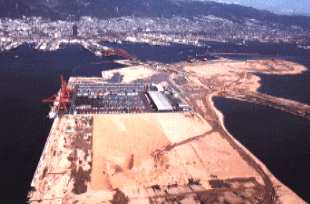
The Port Island under construction (1972)
(Provided by Kobe City Harbor Service Bureau)
Leaps (the Heisei period)
The reclamation work of Rokko Island in Kobe Port was completed in the beginning of the Heisei period. The second phase of Port Island construction was also rapidly implemented.
In April 1996, Japan's first large berth with 15m depth started operation, enabling large container ships of 50,000-ton class to enter the port.
With the expansion of harbor facilities of Kobe Port, the roles of Kobe Customs have been significantly increased.
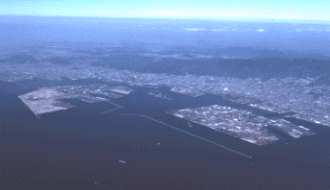
Kobe Port of today
(Provided by Kobe City Harbor Service Bureau)
The third building of Kobe Customs headquarters office
The construction of the third building of the headquarters office started in April 1996 and was completed in November 1998.
The old building with the clock tower being preserved, this building was designed to present a ship-like appearance and was reborn as a new symbol of Kobe Port.
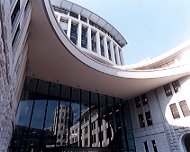
Entrance
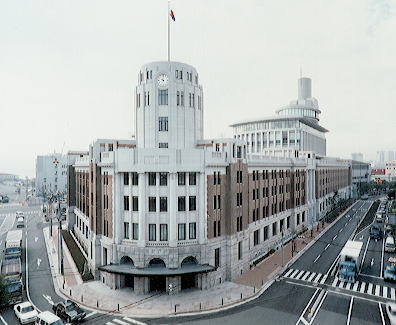
A view from northeast of Kobe
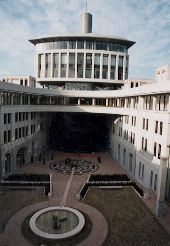
Courtyard
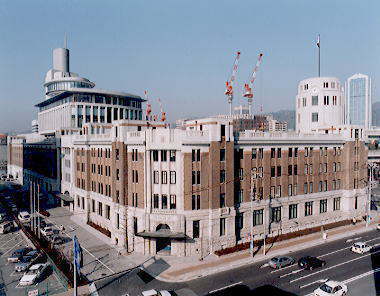
A view from southeast of Kobe
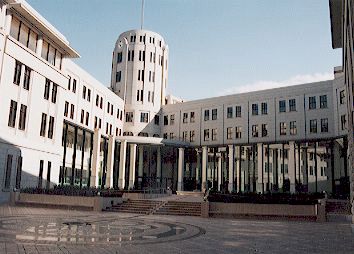
Courtyard
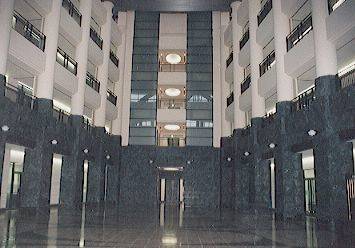
The Atrium of the new building




![Customs Channel[YouTube]](/english/common2018/img/banner-youtube.jpg)

